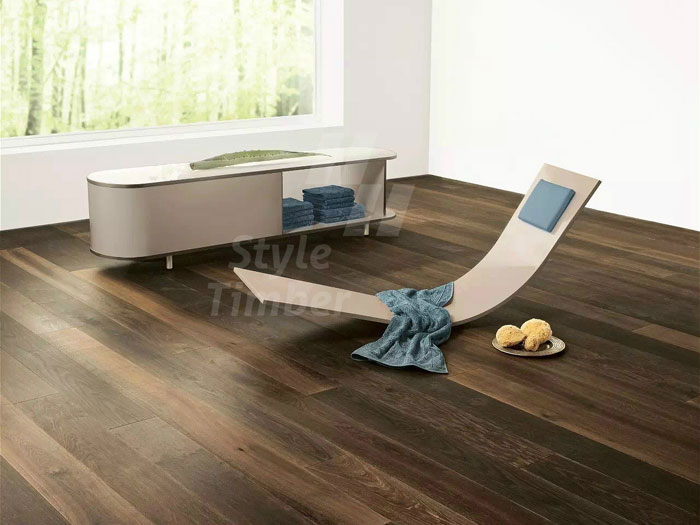The colour of the flooring has an important impact on the overall design and vibe of the room. While the choice between light and dark tones basically comes down to personal preference, there are several other factors to consider such as the size of the room, entry of natural light, furnishings and furniture, and design theme among others.
Read on to learn more about all the influencing factors and how each element’s impact needs to be considered before deciding on the colour of your timber flooring.
How big is your room?
The size of the room is an important consideration when selecting the timber floor colour. A dark floor can make the space look smaller; while this doesn’t affect larger rooms, it can be a problem in compact spaces.
If your design canvas is a large room, using warmer tones for the floor is recommended since these colours tend to draw a room in, making it look and feel cosier, while giving a more dramatic contrast at the same time. Conversely, lighter colours on the floor make the room appear more spacious; pale shades are, therefore, ideal for smaller spaces.
This is why it’s crucial to assess the advantages and drawbacks of the visual illusion that flooring may create when light or dark colours are used. For inspiration, check out the Mega collection by Style Timber Floor. The classic 220mm wide engineered timber boards combine both modern and antique finishes and the generous 6mm Oak top layers guarantee they will have the same lifespan as traditional hardwood floors. These floors have been refined with brushing, hand scraping, smoking and staining techniques to create magnificent textural experiences.

Is your room well-lit naturally?
Lighting is an equally important factor to consider when selecting the flooring for an interior space. Does the room draw in copious amounts of natural light?
A dark floor can make a room appear darker than it really is compared to light coloured flooring, especially if the room is naturally dark. A dark floor is perfect if your design objective is to create a cosy atmosphere. However, if the room is a workspace such as a home study or a kitchen, the lack of natural light can become problematic since you will need to bear the additional cost for artificial lighting to make the room brighter.
Again, darker tones on the floor will work well in a room that is naturally well-lit. Light coloured flooring in a bright room, on the other hand, may not look visually interesting.

Have you finalised your furniture?
When designing an interior space, there’s nothing more ideal than a blank canvas where you can coordinate and put together various elements including the flooring in perfect harmony. However, in remodelling projects, there’s a good chance you will have to work with existing furnishings and furniture, in which case, your flooring choice will be influenced by the design theme of the room, the overall styling and the colours already in place.
You will have to consider the overall look of the room with both dark and light flooring options. For example, a light coloured floor has more impact on the room when contrasted with darker detailing. Hence, by putting together the important elements in the space, you will be able to choose the tone that works best in the space without clashing or looking out of place.
For inspiration, have a look at this case study at Ed. Square, Edmondson Park. To match the colour schemes of the new development, Style Timber developed two new colours, Pebble Grey and Moschino, with the 190mm boards wide enough to actually make the space look bigger but also small enough to not look out of proportion. Style Timber’s 190mm wide engineered timber boards are the perfect fit for apartment living and small spaces.

Rustic or Modern – What’s your design theme?
The choice of flooring colour will also depend on the interior design theme of the room. For example, if you are going for a cosy and rustic feel, a dark wood floor may be the right choice. This is because dark timber floors match more aesthetically with the furniture associated with this provincial and restful design.
On the other hand, a lighter wood floor may be the best option for a contemporary living space. This is because lighter timber tones pair well with the edgy furniture and metallic fittings typically used in modern interiors.

